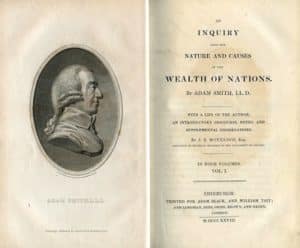The Marshall Plan is more than a historical event — it has become a modern myth. As such, it may be mostly true or mostly false, but it exercises a powerful hold over reality. And the perceived success of the Marshall Plan has influenced American policy since the late 1940s.
— Tyler Cowen
The European Recovery Program, known as the Marshall Plan was an American post–World War II program by which approximately $13 billion was used to rebuild the economies of nations in Western Europe. ($13 billion is about $130 billion in 2016 dollars. Some historians, such as Joseph Stromberg, place the figure as high as $17 billion.) The Marshall Plan set a precedent.
Western European nations were offered loans with which they purchased American goods. The U.S. government was now officially encouraging “private” investment abroad. For example, “political risk insurance” was issued by the government to protect American businesses abroad against adverse political situations, such as a civil war, which could cause financial losses. One provision of the Marshall Plan granted long-term guarantees for qualified investors to convert foreign funds into U.S. dollars even during periods of so-called dollar shortages. Qualified investors tended to be state-crony corporations or state-favored individuals.
Since the late 1940s, foreign investment and the resulting corporate profits have been a driving force in establishing U.S. military bases around the globe. The state-protected investments are falsely touted as expressions of the free market and foreign trade rather than cronyism and economic imperialism.
The Marshall Plan and ensuing U.S. policy
In 1942, shortly after America’s entry into World War II, the Committee for Economic Development (CED) was founded by Paul G. Hoffman in association with other businessmen, most of whom held positions in big corporations or government. The CED’s stated goal was to assist the U.S. in shifting from a wartime economy to a peacetime one. The goal quickly changed to promoting the Marshall Plan. In his essay “The Marshall Plan Myth,” free-market analyst Jeffrey A. Tucker explained that CED members included “heads of the top steel, automotive, and electric industries who had benefited from the New Deal’s corporatist statism.” In other words, the CED used the Marshall Plan to export New Deal economics to foreign nations in order to benefit crony corporations. State-favored corporations had profited richly from the war but all that was about to end. They wanted a way to continue their huge profits in a time of peace.
Fortunately for the CED, its interests and those of President Harry Truman aligned. The presidency was in trouble. By 1945, America was weary of war and wanted to loosen the reins of government which had tightened during World War II; Truman’s popularity and power declined. In the 1946 election, the Republicans seized control of both houses of Congress on a platform of rolling back government. In the 1948 presidential election, many were so certain that the Republican candidate, Thomas Dewey, would win that the Chicago Tribune prematurely printed newspapers with the front-page head-line “Dewey Defeats Truman.” He didn’t. But the vote totals were only about 4 percent apart.
Truman needed a popular cause around which the public and his party would rally. He found it in the bombastic campaign against communism both domestically and abroad. The Truman Doctrine of 1947 was a declaration of Cold War on a global scale and it had been well received. The doctrine offered U.S. military and economic support to nations that were threatened by communist troops or insurrections.
Truman found another popular cause in the Marshall Plan. First proposed by Secretary of State George C. Marshall, it was seen and sold as a moral campaign as well as a security matter; while showing compassion, it would diminish the influence of communism in Western Europe.
To the U.S. corporate state, a marriage of the Truman Doctrine and the Marshall Plan must have seemed ideal. It was said to create employment in America; tax dollars in the form of loans bought products from corporations; corporate investment overseas was protected by state privileges and a U.S. military presence.
At least two things were wrong with the package, however. It didn’t work. And it damaged the true interests of America, including the free market and noninterventionism.














